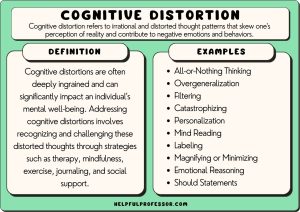Cognitive Behavioural Therapy (CBT) – What Are Cognitive Distortions?
Cognitive distortions are negative thinking patterns that can affect mood and behaviour. While many people experience these distortions occasionally, they can become habitual and cause problems over time, including anxiety, depression and relationship difficulties. A cognitive behavioural therapist can help you identify and overcome your distortions to promote better moods.
CBT sessions are interactive and include question-and-answer sessions, worksheets and journaling. Your therapist will teach you how to recognise unhealthy emotions and beliefs in the context of difficult situations. You will also learn techniques for managing these emotions and beliefs. Your therapist will then work with you to replace your negative automatic thoughts with more balanced, realistic thinking, which can be a long process but is well worth the effort.

A cognitive distortion can be any thought pattern that is unhelpful, irrational and not grounded in reality. It is a way of viewing the world that may not be helpful in predicting and responding to the challenges we encounter. Cognitive distortions develop over time when a person has certain automatic thoughts about a situation that then triggers specific emotions and behaviours. This chain of events is known as the thought-emotions-behaviour loop and can become quite ingrained.
What Are Cognitive Distortions?
Common cognitive distortions include polarized thinking, filtering, overgeneralisation and the change fallacy. In polarized thinking, things are seen as either good or bad, there is no grey area. When someone engages in this distortion they might believe they are a failure because they didn’t meet their goals for the year, or that their coworkers are evil because they got a promotion while they did not.
Another common cognitive distortion is the overestimation of negative consequences. This is a way of thinking that can cause you to become anxious and pessimistic, as you believe that the worst possible outcome will happen. Overestimating negative consequences can lead to avoidance, low self-esteem and poor coping skills.
A third cognitive distortion is emotional reasoning. This is where you believe that the emotions you are feeling are a reflection of reality. “I feel it, therefore it must be true.” This can cause a person to ignore or downplay positive experiences, for example, if they get praise for their work, believing it was a fluke or luck rather than something they worked hard at.
The final cognitive distortion is the change fallacy where you assume that other people need to change their behaviour in order for you to be happy. This can make you feel powerless and can be especially harmful in relationships. It can also lead to feelings of anger and frustration. It is important to remember that other people’s behaviours are largely a result of their own internal factors, such as their beliefs, values and needs. If you are able to understand these motivations, you can better empathise and accept them. This will help you to have more productive and fulfilling relationships.